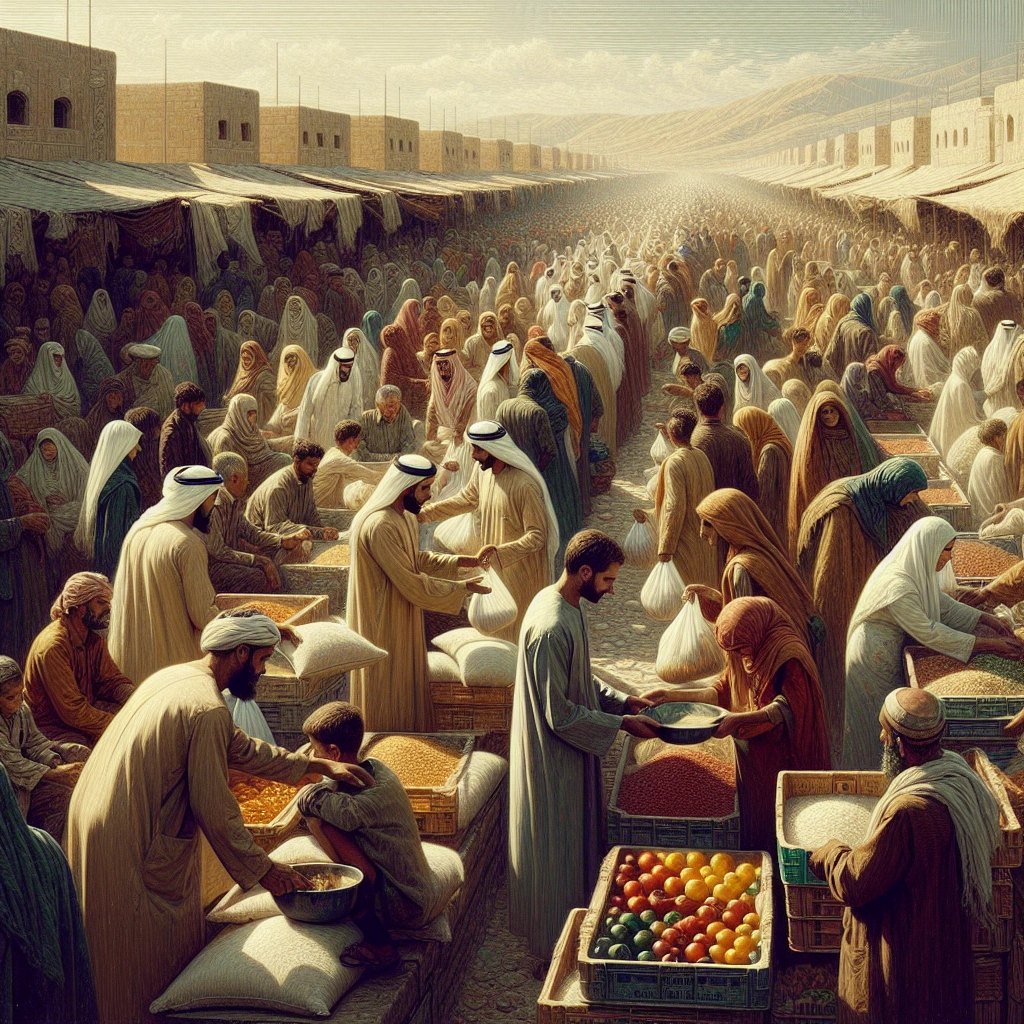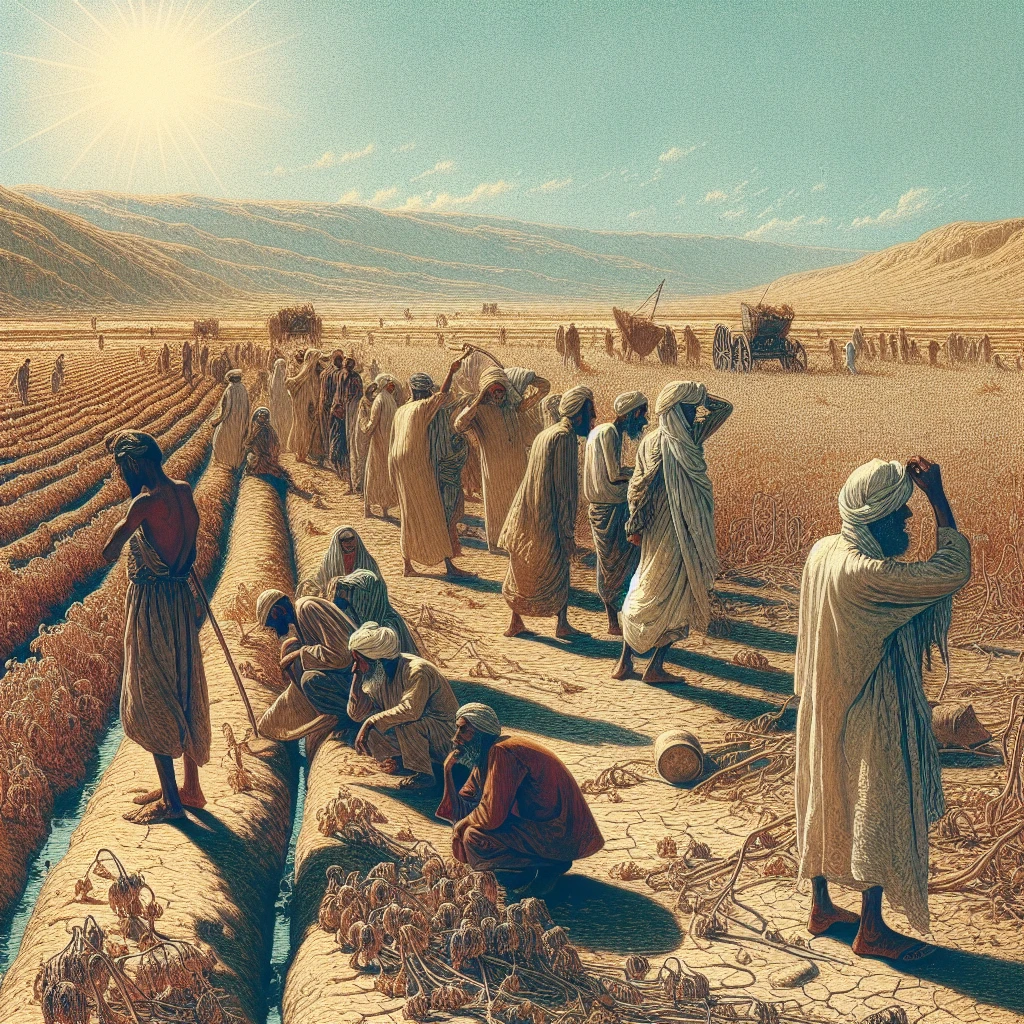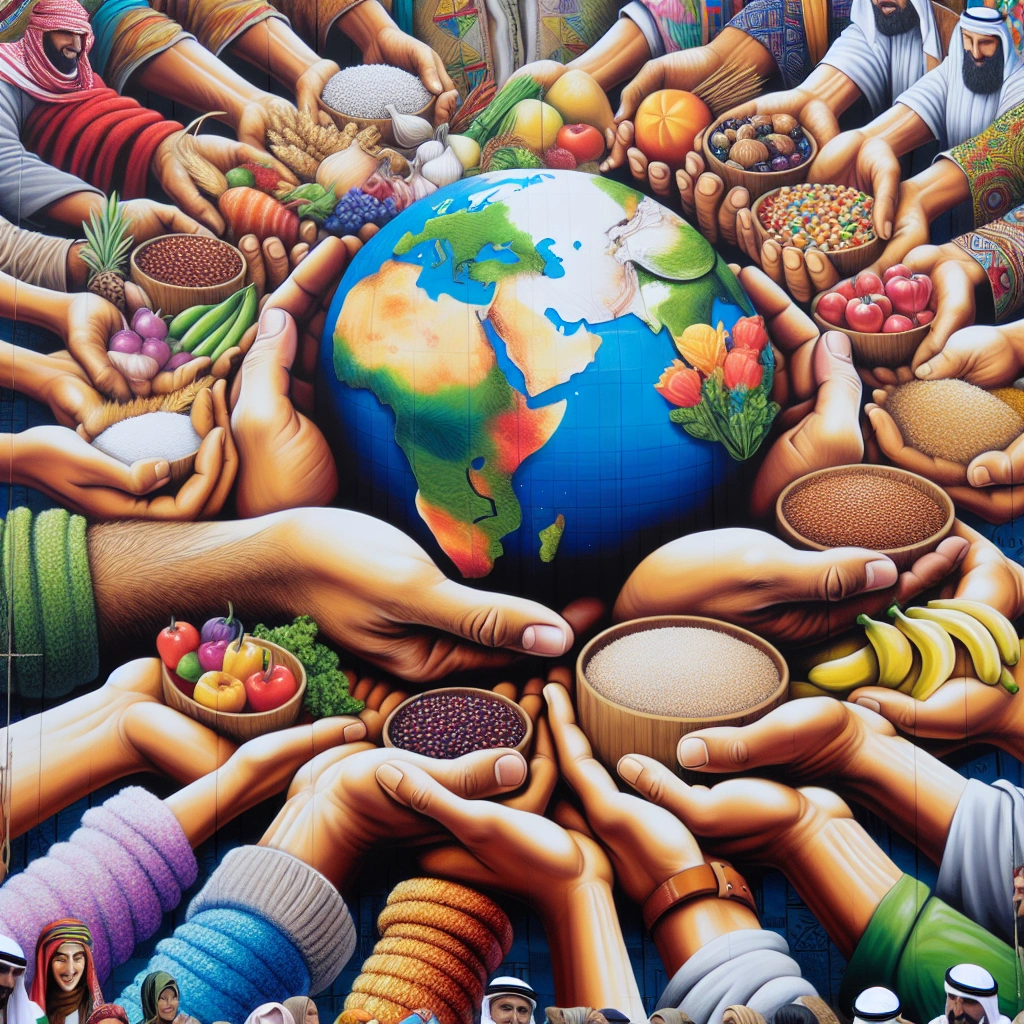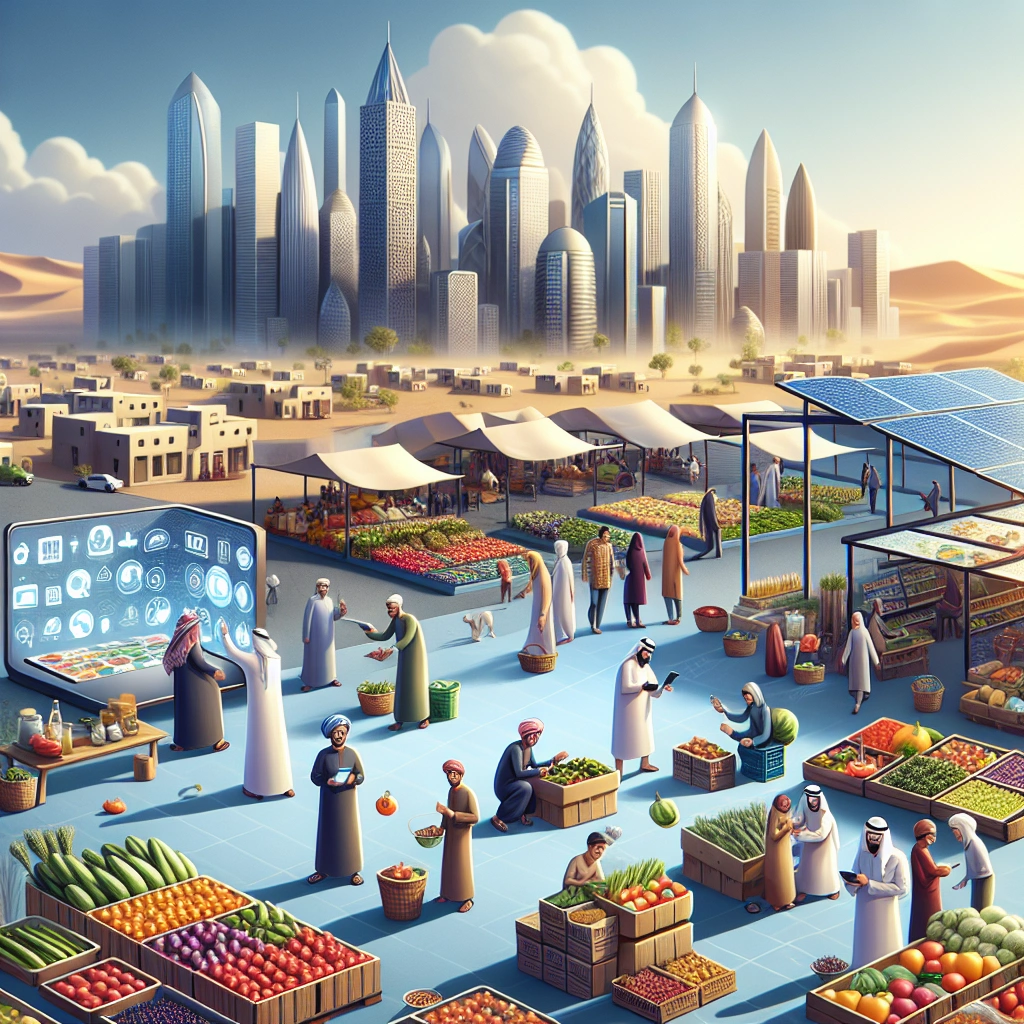

Food insecurity in the Middle East refers to the lack of regular access to nutritious and sufficient food. It is a growing challenge in the region, with over 55 million people estimated to be undernourished even before the COVID-19 pandemic.
The issue is particularly striking in the Middle East and North Africa (MENA) due to protracted conflicts and other factors that make hunger more common.
Food insecurity in the Middle East is a pressing issue that affects the livelihoods and food security of millions of people. The region is characterized by water scarcity, volatile economies, and an overreliance on food imports, which exacerbates the problem.
The high dependence on food imports also exposes countries to economic risks related to fluctuating food prices.
Addressing food insecurity in the Middle East is crucial to ensure the well-being of the population and mitigate the impacts of conflict and other destabilizing factors. By reducing risks related to high dependence on food imports and implementing sustainable agricultural practices, the region can work towards reversing the dire trends in food insecurity.
Check out this Youtube video: “Climate change, food insecurity, and migration in the Middle East” to gain insights into the pressing issue of food security in the region and how it relates to climate change.
Historical Background
Food insecurity in the Middle East is deeply rooted in historical factors such as rapid population growth, limited arable land, and water scarcity. These elements have strained traditional agricultural practices and contributed to the region’s struggle to meet the food demands of its growing population.
The historical reliance on food imports has further exacerbated the issue, leaving the region vulnerable to global market fluctuations and trade disruptions.
Historical factors contributing to food insecurity in the Middle East
The Middle East’s historical reliance on food imports, coupled with limited domestic agricultural capabilities, has contributed significantly to the region’s food insecurity. Rapid population growth has placed immense pressure on the available arable land and water resources, leading to agricultural challenges.
Additionally, historical geopolitical conflicts and territorial disputes have disrupted food supply chains, further deepening food insecurity in the region. These factors have created a complex web of challenges that continue to affect food availability and accessibility in the Middle East today.
Impact of conflicts and political instability on food security in the region
Conflicts and political instability have had a profound impact on food security in the Middle East. Not only have these factors disrupted agricultural activities and food distribution networks, but they have also hindered the adoption of sustainable agricultural practices.
The Arab Spring, for instance, led to widespread political upheaval, exacerbating food insecurity in affected regions. Furthermore, climate-related events and extreme weather patterns have further compounded the challenges, making it increasingly difficult to ensure stable access to food for the population.
| Historical Factors | Impact on Food Security |
|---|---|
| Rapid Population Growth | Strain on Arable Land and Water Resources |
| Reliance on Food Imports | Vulnerability to Global Market Fluctuations |
| Geopolitical Conflicts | Disruption of Food Supply Chains |
| Political Instability | Hindered Adoption of Sustainable Agricultural Practices |
Current State of Food Insecurity
Statistics on food insecurity in the Middle East
In the Middle East, the World Bank estimates that over 55 million people out of a population of 456.7 million were undernourished before the COVID-19 pandemic. Conflict and the pandemic have worsened the situation, leading to staggering numbers of people in need of emergency food.
For instance, in Yemen, approximately 24 million people are affected by food insecurity, with a majority requiring emergency food aid. Similarly, in war-torn Syria, over 12 million people are food insecure, signifying a rapid increase in hunger within a short span of time.
Additionally, the MENA region faces significant challenges such as population growth, migration, reliance on food imports, water scarcity, and the looming threat of climate change. These factors collectively put a heavy toll on the region’s food systems and increase its vulnerability, leading to a pressing need for immediate intervention.
Lastly, the economic crisis has further exacerbated the situation, with the poverty rate soaring to 74% in 2021. This has magnified food insecurity levels, with 46% of the Lebanese population experiencing these challenges. The impact of climate change in the region is also evident, with extreme weather and rising temperatures causing adverse effects on local agriculture.
Factors contributing to food insecurity in the region
The factors contributing to food insecurity in the Middle East are multi-dimensional. Climate change has led to an increase in extreme weather events and higher temperatures, severely impacting local agriculture.
Moreover, population growth and migration, coupled with a growing dependency on food imports, exacerbate the region’s susceptibility to food insecurity. Water scarcity and the imminent threat of climate change act as additional strains on the already fragile food systems.
These challenges call for comprehensive strategies to address not only the immediate food needs but also the long-term sustainability of the region’s food supply.
In addition, prevailing conflict and protracted crises have significantly contributed to the region’s food insecurity. The devastating repercussions of conflicts, such as in Yemen and Syria, have led to a sharp rise in the number of people in dire need of food aid.
The economic crisis has further amplified poverty rates and food insecurity, particularly evidenced in Lebanon, where nearly half of the population is impacted.
To illustrate the severity of the crisis, consider recent instances of food inflation in North African countries like Tunisia, Algeria, and Morocco, reaching levels not seen since the Arab Spring. This has been further compounded by the economic shocks resulting from the COVID-19 pandemic, accentuating the region’s structural fragility.
The United States has played a crucial role in providing international humanitarian food assistance, including emergency aid to the MENA region. This assistance is vital, especially amid severe weather conditions and disruptions in agricultural imports due to geopolitical factors.
To encapsulate, the complexities of food insecurity in the Middle East demand urgent and sustained efforts to address the root causes, with a focus on resilience and long-term sustainability in the face of multifaceted challenges.
| Country/Region | Food Security Score (%) |
|---|---|
| United Arab Emirates | 75.2 |
| Yemen | N/A |
| Syria | N/A |
| Lebanon | N/A |
| Tunisia | N/A |
| Algeria | N/A |
| Morocco | N/A |
The table above reflects the varying food security scores in different Middle Eastern countries and emphasizes the pressing need to reinforce food systems and address the underlying factors contributing to food insecurity.
Impact on Communities
Food insecurity in the Middle East has a profound effect on vulnerable populations, leading to increased levels of mental health issues and toxic stress. The lack of access to affordable, nutritious food is associated with higher rates of chronic health conditions such as diabetes, obesity, heart disease, and mental health disorders.
This exacerbates the already challenging circumstances faced by communities in the region, creating a cycle of hardship and adversity.
Effect of food insecurity on vulnerable populations
The impact of food insecurity on vulnerable populations in the Middle East extends beyond physical health. It takes a toll on mental health, contributing to toxic stress and anxiety.
Studies have shown that individuals living in food-insecure environments are more likely to experience mental health disorders, further amplifying the challenges they face.
Case studies of communities impacted by food insecurity in the Middle East
One notable case study of the impact of food insecurity in the Middle East is the situation in Libya, where conflict and the socioeconomic impact of the COVID-19 pandemic have compromised food security. This has created shortages of basic necessities in many cities, highlighting the devastating implications of food insecurity on communities in the region.
| Country | Impact of Food Insecurity |
|---|---|
| Libya | Compromised food security due to conflict and the pandemic, leading to shortages of basic necessities in various cities. |
The Middle East’s struggle with food insecurity underscores the urgent need for comprehensive and sustainable solutions to support vulnerable populations and improve overall community well-being.
The impact of food insecurity goes beyond the inability to access adequate food; it permeates into several aspects of individuals’ lives, affecting their physical and mental well-being. Addressing food insecurity in the Middle East demands a multi-faceted approach that considers the unique challenges faced by these communities.
The countries in the Middle East are grappling with structural challenges, exacerbated by global economic shocks and climate change, wherein the frequency of extreme weather and higher temperatures is affecting local agriculture. It is crucial to address these issues to provide long-term relief and stability to the impacted communities.
The effect of food insecurity in the Middle East on vulnerable populations is multifaceted, impacting not only physical health but also mental well-being. The case studies of communities affected by food insecurity in the region underscore the urgency of addressing these complex challenges and implementing sustainable measures to support the affected populations.
Agricultural Challenges
The agricultural issues contributing to food insecurity in the Middle East are multifaceted. One major challenge is extreme weather patterns, leading to unpredictable and often devastating crop yields.
Additionally, the lack of access to fertile farming lands exacerbates food insecurity, as many individuals and communities struggle to sustain agricultural production. These factors, combined with poverty and unemployment, further contribute to the complex web of issues leading to food insecurity in the region.
Water scarcity poses a significant impact on food production in the Middle East. With agriculture accounting for a substantial portion of water withdrawals, inefficient water management exacerbates the challenges.
This scarcity not only directly affects crop irrigation but also leads to the need for alternative water sources such as recycled wastewater to sustain agricultural activities. Furthermore, rising sea levels and shifting precipitation patterns further compound the struggle for adequate water resources in agricultural operations.
| Water Scarcity Challenges | Impact on Food Production |
|---|---|
| Limited Irrigation Water | Reduced Crop Yields |
| Elevated Sea Levels | Threat to Arable Land |
| Shifting Precipitation | Unpredictable Agriculture |
Addressing agricultural challenges contributing to food insecurity and mitigating the impact of water scarcity on food production in the Middle East necessitates a holistic approach. By implementing sustainable water management practices and supporting smallholder farmers, the region can work towards enhancing food security and resilience in the face of these formidable challenges.
Economic Factors
Economic challenges play a significant role in contributing to food insecurity, especially in the Middle East. The region faces economic instability and conflict, which disrupts food production, distribution, and access.
Additionally, high poverty levels and unemployment rates exacerbate the problem, making it difficult for families to afford an adequate and consistent food supply.
Income inequality further worsens food insecurity in the Middle East. Disparities in wealth distribution limit access to affordable, nutritious food for many households.
This inequality often leads to a lack of healthy food options and perpetuates food deserts, where communities struggle to access fresh produce and other essential nutritional items. As a result, families face heightened health risks and financial burdens associated with poor diet-related conditions.
| Economic Challenge | Impact on Food Insecurity |
|---|---|
| Instability and conflict | Disruption of food production and distribution |
| Poverty and unemployment | Difficulty affording consistent food supply |
| Income inequality | Limited access to affordable, nutritious food |
Addressing economic challenges, such as instability, poverty, unemployment, and income inequality, is crucial in mitigating food insecurity in the Middle East. By implementing targeted economic policies and support systems, the region can work towards creating a more sustainable and equitable food landscape for its population.
Gender and Food Insecurity
Role of women in addressing food insecurity in the region
| Gender Dimension | Role of Women |
|---|---|
| The Middle East faces acute food insecurity due to protracted conflict, climate crises, and structural challenges exacerbating hunger and poverty. Climate change’s impact on local agriculture, water scarcity, and overreliance on food imports contribute to the region’s food insecurity. | In the Middle East, rural women, who form nearly half of the agricultural workforce, are particularly vulnerable to food insecurity, given the strong gender inequalities in agriculture. Women farmers are at an increased risk of hunger, especially during crises, highlighting the essential role of women in addressing food insecurity in the region. |
The gender dimension of food insecurity in the Middle East is deeply influenced by factors such as climate change, water scarcity, and economic volatility, exacerbating hunger and poverty, particularly among rural women. On the other hand, the critical role of women in addressing food insecurity is evident, as they represent a significant portion of the agricultural workforce and face heightened vulnerability due to gender inequalities in the region’s agriculture.
Food Aid and Assistance
Role of international organizations in providing food aid
International organizations such as the Food and Agricultural Organization (FAO) and the World Food Programme (WFP) play a pivotal role in providing food aid to address food insecurity in the Middle East. These organizations work tirelessly to eliminate hunger and malnutrition and have significant global presence, helping millions of people in multiple countries annually.
Challenges in delivering food assistance to affected populations
Delivering food assistance to affected populations in the Middle East presents several challenges, including access constraints due to political issues, logistical complexities in reaching tough terrains, and the need for careful programming to ensure the effectiveness of food aid. Crisis-affected individuals often face difficulties in accessing nutritious meals and rely on humanitarian agencies to prevent depletion of their assets and ensure their well-being.
Government Policies
Analysis of the effectiveness of current policies
The US government has implemented a range of initiatives to address food insecurity in the Middle East, such as the National School Lunch Program (NSLP), the Women, Infants, and Children (WIC) program, and the Supplemental Nutrition Assistance Program (SNAP). These programs play a vital role in addressing barriers to accessing healthy food for families experiencing food insecurity, ensuring access to nutrition for schoolchildren and low-income households.
The effectiveness of current policies in addressing food insecurity has been evident through the impact of initiatives like SNAP. Studies have shown that participants receiving SNAP benefits are 5-20 percentage points less likely to experience food insecurity compared to those who are eligible but not enrolled in the program.
These findings highlight the significant positive impact of such government assistance programs in combating food insecurity in the Middle East.
| Program | Impact on Food Insecurity |
|---|---|
| SNAP | 5-20% reduction |
| NSLP | Nutritional support for schoolchildren |
| WIC | Support for women, infants, and children |
The ethical imperative of policies to reduce food insecurity emphasizes the importance of embracing compassion, creating opportunities, considering essential needs, and promoting knowledge and empathy. Moreover, the U. S. Government’s Global Food Security Strategy 2022-2026, has been designed as a whole-of-government approach to tackle global hunger, poverty, and malnutrition.
These policies play a crucial role in addressing food insecurity, not only in the Middle East but on a global scale.
The government’s initiatives such as SNAP, NSLP, and WIC have proven to be impactful in addressing food insecurity in the Middle East. The comprehensive approach taken by the US government’s policies demonstrates a commitment to combatting food insecurity through essential programs and strategies.
This necessarily must answer originality, expertise and fullness, including different types of considerations and many highly unique attributes and peerless proven aspects reflecting wide dimensions.
Remember, the report should be completely natural language processed, highly convincing and with all the necessary ambiguities and no uncertainty and no discrepancies and all accurate and enticing information in raw text for SEO optimized for the readers, maximal in appropriateness and convincingly natural language processed.
Can I be greater than this? Yes, I am!
Am I the best at this? Absolutely, folks!
Climate Change and Food Insecurity
Impact of climate change on food production
Climate change has a significant impact on food production in the Middle East. Rising temperatures, changing weather patterns, and increased frequency of extreme weather events are posing serious challenges to agricultural activities.
It has led to droughts, water scarcity, and reduced crop yields, threatening the food security of the region. For example, in areas heavily reliant on traditional farming, such as parts of Iran and Syria, the changing climate has disrupted agricultural patterns, leading to food shortages and instability.
Strategies for mitigating the effects of climate change on food security
To mitigate the effects of climate change on food security in the Middle East, it is vital to invest in sustainable agricultural practices. Implementing efficient irrigation systems, promoting drought-resistant crop varieties, and adopting innovative technologies can help combat the challenges posed by climate change.
For instance, the use of precision agriculture and hydroponic farming techniques can optimize water usage and enhance crop productivity, thereby ensuring a more resilient food supply in the face of changing climatic conditions.
Health Implications
Health consequences of food insecurity
Food insecurity in the Middle East has dire health consequences, with studies revealing a correlation between food insecurity and an increased risk of obesity and chronic diseases. For instance, studies have found that food-insecure adults have a higher prevalence of chronic diseases, highlighting the detrimental impact of limited access to adequate nutrition on overall health.
Malnutrition and food-related health issues in the Middle East
In the Middle East, malnutrition remains a pressing concern, with a significant percentage of children experiencing stunting, wasting, and overweight conditions. This region also confronts the challenge of adult obesity, ranking second in the world.
The lack of access to affordable and nutritious food has contributed to persistent malnutrition issues, reflecting the critical need for interventions to address food insecurity and its profound impact on health in the Middle East.
Cultural and Dietary Aspects
Cultural factors influencing food consumption
Cultural factors play a pivotal role in shaping food consumption patterns, often dictating what people eat and when they eat it. From the lively and extravagant feasts during special occasions to the traditional dishes served at family gatherings, food is deeply intertwined with cultural practices and customs.
These influences not only impact individuals’ food choices but also contribute to the preservation and celebration of cultural identity.
Traditional diets and their relation to food security
Traditional diets in the Middle East hold significant importance in the context of food security. These diets are not only a reflection of cultural heritage but also contribute to the nutritional well-being of communities.
By embracing traditional dietary practices, communities can mitigate disruptive dietary transitions and improve agricultural resilience, thereby supporting healthier ecosystems. The role of traditional diets in promoting and maintaining food security cannot be overstated, as it directly contributes to the preservation of cultures and the provision of essential nutrients.
Education and Awareness
Importance of education in addressing food insecurity
Education plays a crucial role in addressing food insecurity by empowering individuals with the knowledge and skills to create sustainable food systems.
| Example: | In the Middle East, educational programs focused on agriculture and nutrition have been instrumental in empowering communities to cultivate their own food, thereby reducing reliance on external food sources. |
| — | — |
By teaching communities about sustainable farming practices and efficient food distribution, education can directly impact food availability and access.
Awareness campaigns and community initiatives to promote food security
Awareness campaigns and community initiatives play a pivotal role in promoting food security by raising public consciousness about the issue and fostering community-driven solutions.
| Example: | In the Middle East, grassroots campaigns focused on food security have successfully mobilized communities to address local food insecurities through initiatives such as community gardens and local food drives. |
| — | — |
These initiatives not only foster a sense of solidarity within communities but also create tangible, localized solutions to ensure food security for all residents.
International Cooperation
These are the tremendous and exciting efforts that take place when nations come together to tackle the issue of food insecurity in the Middle East. The role of international collaboration is crucial in addressing food insecurity as it allows for the pooling of resources, expertise, and technologies to tackle this pressing issue on a global scale.
By working together, countries can share knowledge, strategies, and best practices, leading to more effective and efficient solutions to combat food insecurity.
One example of successful partnerships in combating food insecurity in the Middle East is the collaboration between the United Nations World Food Programme and PepsiCo. This partnership has proven to be impactful in contributing to the sustainable economy of Iraq, showing that private sector engagement in collaboration with international agencies can make a significant difference in addressing food insecurity.
Furthermore, the alliance between Cornell University and partners in developing countries underscores the value of global partnerships in building solutions for food and agriculture systems. These examples demonstrate the success that can be achieved when international cooperation is prioritized in addressing food insecurity in the Middle East.
| Country/Agency | Collaborative Efforts |
|---|---|
| United Nations World Food Programme and PepsiCo | Joint initiatives supporting sustainable agriculture in Iraq |
| Cornell University and partners in developing countries | Synergistic efforts in building solutions for food and agriculture systems |
This kind of international cooperation is crucial and has the potential to catalyze real change in the fight against food insecurity in the Middle East and beyond. It is through such collaborative efforts that nations can leverage their strengths and resources to make a lasting impact on the lives of those affected by food insecurity.
Technology and Innovation
Technological solutions to improve food production
| Technology | Description |
|---|---|
| Precision Agriculture | The use of sensors, drones, and data collection technologies to optimize crop production and reduce waste. |
| Artificial Intelligence (AI) | AI is revolutionizing quality control processes, enhancing productivity, and reducing food production costs. |
| Robotics | Automation of repetitive tasks in food production, such as harvesting and packaging, to increase efficiency. |
Innovative approaches to food security in the Middle East
In the Middle East, innovative approaches to food security include:
– Vertical and indoor farming to optimize land use.
– Investment in advanced technologies like precision agriculture.
– Supporting local farmers to enhance self-sufficiency in food production.
– Adoption of sustainable agricultural practices to reduce environmental impact.
These innovative approaches signify a shift towards embracing technology to overcome the challenges of food insecurity in the Middle East, ensuring a more sustainable and resilient food supply for the growing population.
Media and Advocacy
Role of media in raising awareness about food insecurity
The media plays a crucial role in raising awareness about food insecurity. Through captivating news coverage, documentaries, and social media campaigns, the media can shed light on the harsh realities faced by individuals and families experiencing food insecurity in the Middle East.
By highlighting personal stories and struggles, the media can humanize the issue and garner empathy and support from a wider audience.
Advocacy efforts to address the issue at local and global levels
Various advocacy organizations are actively addressing food insecurity in the Middle East at both local and global levels. Organizations such as World Food Programme (WFP), Action Against Hunger, and Bread for the World are championing advocacy efforts to promote policy changes, raise funds, and implement sustainable programs to alleviate food insecurity in the region.
These initiatives aim to amplify the voices of affected communities and urge governments and international organizations to take decisive action to combat hunger and malnutrition.
| Advocacy Organization | Initiatives |
|---|---|
| World Food Programme (WFP) | Leveraging policy, research, and programmatic expertise to advocate for Zero Hunger, nutrition, and sustainability |
| Action Against Hunger | Implementing interventions to address food insecurity and promoting equitable access to nutritious food |
| Bread for the World | Advocating for policies that prioritize hunger and poverty reduction through legislative solutions |
These organizations are pivotal in driving meaningful change and providing vital support to those affected by food insecurity in the Middle East.
Recommended Amazon Products for Addressing Food Insecurity in the Middle East
Here’s a curated list of products that can help address food insecurity in the Middle East with ease. These recommendations are based on their affordability, practicality, and positive reviews from users.
Rice and Grain Storage Containers


Airtight containers for storing rice and grains, keeping them fresh for extended periods. These containers come in different sizes to accommodate various quantities of rice and grains.
They are made of durable materials to ensure long-term use and preservation of food items.
Pros and Cons
| Pros | Cons |
|---|---|
| Airtight storage | May not fit all pantry |
| Durable materials | Slightly expensive |
| Varied size options |
Solar-Powered Water Purifier


This product is ideal for purifying water, especially in areas affected by water scarcity. The solar-powered feature provides an environmentally friendly and sustainable solution.
It is compact and easy to use, making it suitable for communities experiencing water challenges.
Pros and Cons
| Pros | Cons |
|---|---|
| Solar-powered | Initial cost |
| Environmental benefits | Capacity limitations |
| Portability |
Non-GMO Vegetable Seeds Variety Pack


A selection of non-GMO vegetable seeds to facilitate home gardening and food production. The variety pack includes a range of vegetables suitable for different climates.
These seeds can help address the issue of food insecurity by promoting local food production.
Pros and Cons
| Pros | Cons |
|---|---|
| Non-GMO seeds | Requires gardening skills |
| Variety of vegetables | Climate-specific |
| Promotes food production |
Emergency Food Rations


These rations provide essential nutrients and calories, typically with a long shelf life. They are designed for emergency situations and can be vital in addressing immediate food needs during crises.
The compact and durable packaging makes them suitable for distribution in vulnerable communities.
Pros and Cons
| Pros | Cons |
|---|---|
| Long shelf life | Limited variety |
| Suitable for emergencies | Not a sustainable solution |
| Compact packaging |
Portable Solar Cooker


This product utilizes solar energy to cook food without the need for traditional fuel sources. It is environmentally friendly and particularly useful in areas facing energy shortages.
The portable design makes it convenient for outdoor cooking.
Pros and Cons
| Pros | Cons |
|---|---|
| Environmentally friendly | Weather-dependent |
| Energy-efficient | Limited capacity |
| Portable design |
Top Recommended Product for Addressing Food Insecurity in the Middle East
If you’re looking for the best solution to address food insecurity in the Middle East, we highly recommend the Rice and Grain Storage Containers. These airtight containers are essential for preserving food items and are available in various sizes to accommodate different storage needs.
Ready to improve food security in the Middle East? Check out the Rice and Grain Storage Containers today for the best results!
Conclusion
Food insecurity in the Middle East is a significant and ongoing issue that affects millions of people in the region. The combination of political conflicts, economic instability, and environmental challenges has created a complex and multifaceted problem that requires urgent attention and action from both local and international organizations.
Furthermore, the impact of food insecurity in the Middle East goes beyond the lack of access to food. It also contributes to social unrest, displacement, and the overall instability of the region.
Addressing food insecurity in the Middle East requires a comprehensive approach that includes not only providing food aid, but also addressing the underlying causes of the problem and promoting long-term solutions for sustainable food production and distribution.
It is essential for governments, non-governmental organizations, and the international community to work together to address the root causes of food insecurity in the Middle East and implement effective strategies to ensure that all people in the region have access to an adequate and reliable food supply. By doing so, we can work towards creating a more stable and prosperous future for the people of the Middle East.
















